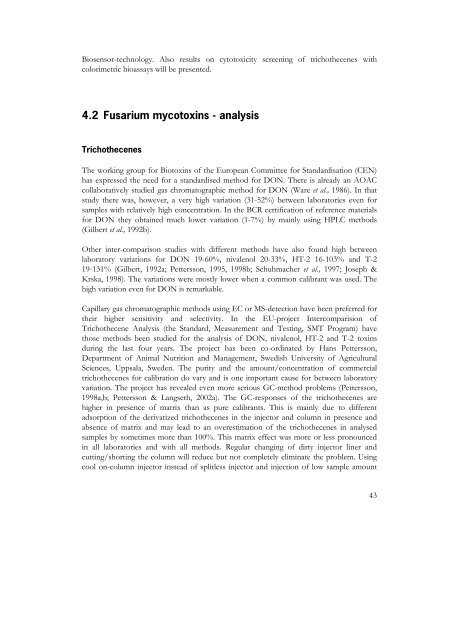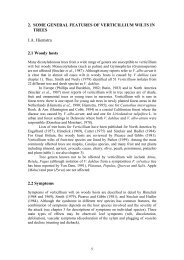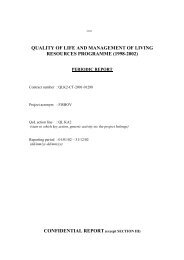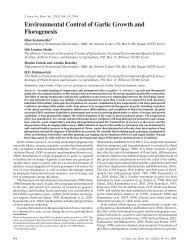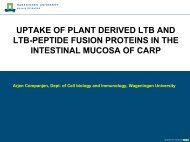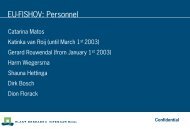3. Fusarium mycotoxins in cereals - Plant Research International ...
3. Fusarium mycotoxins in cereals - Plant Research International ...
3. Fusarium mycotoxins in cereals - Plant Research International ...
Create successful ePaper yourself
Turn your PDF publications into a flip-book with our unique Google optimized e-Paper software.
Biosensor-technology. Also results on cytotoxicity screen<strong>in</strong>g of trichothecenes with<br />
colorimetric bioassays will be presented.<br />
4.2 <strong>Fusarium</strong> <strong>mycotox<strong>in</strong>s</strong> - analysis<br />
Trichothecenes<br />
The work<strong>in</strong>g group for Biotox<strong>in</strong>s of the European Committee for Standardisation (CEN)<br />
has expressed the need for a standardised method for DON. There is already an AOAC<br />
collaboratively studied gas chromatographic method for DON (Ware et al., 1986). In that<br />
study there was, however, a very high variation (31-52%) between laboratories even for<br />
samples with relatively high concentration. In the BCR certification of reference materials<br />
for DON they obta<strong>in</strong>ed much lower variation (1-7%) by ma<strong>in</strong>ly us<strong>in</strong>g HPLC methods<br />
(Gilbert et al., 1992b).<br />
Other <strong>in</strong>ter-comparison studies with different methods have also found high between<br />
laboratory variations for DON 19-60%, nivalenol 20-33%, HT-2 16-103% and T-2<br />
19-131% (Gilbert, 1992a; Pettersson, 1995, 1998b; Schuhmacher et al., 1997; Joseph &<br />
Krska, 1998). The variations were mostly lower when a common calibrant was used. The<br />
high variation even for DON is remarkable.<br />
Capillary gas chromatographic methods us<strong>in</strong>g EC or MS-detection have been preferred for<br />
their higher sensitivity and selectivity. In the EU-project Intercomparision of<br />
Trichothecene Analysis (the Standard, Measurement and Test<strong>in</strong>g, SMT Program) have<br />
those methods been studied for the analysis of DON, nivalenol, HT-2 and T-2 tox<strong>in</strong>s<br />
dur<strong>in</strong>g the last four years. The project has been co-ord<strong>in</strong>ated by Hans Pettersson,<br />
Department of Animal Nutrition and Management, Swedish University of Agricultural<br />
Sciences, Uppsala, Sweden. The purity and the amount/concentration of commercial<br />
trichothecenes for calibration do vary and is one important cause for between laboratory<br />
variation. The project has revealed even more serious GC-method problems (Pettersson,<br />
1998a,b; Pettersson & Langseth, 2002a). The GC-responses of the trichothecenes are<br />
higher <strong>in</strong> presence of matrix than as pure calibrants. This is ma<strong>in</strong>ly due to different<br />
adsorption of the derivatized trichothecenes <strong>in</strong> the <strong>in</strong>jector and column <strong>in</strong> presence and<br />
absence of matrix and may lead to an overestimation of the trichothecenes <strong>in</strong> analysed<br />
samples by sometimes more than 100%. This matrix effect was more or less pronounced<br />
<strong>in</strong> all laboratories and with all methods. Regular chang<strong>in</strong>g of dirty <strong>in</strong>jector l<strong>in</strong>er and<br />
cutt<strong>in</strong>g/short<strong>in</strong>g the column will reduce but not completely elim<strong>in</strong>ate the problem. Us<strong>in</strong>g<br />
cool on-column <strong>in</strong>jector <strong>in</strong>stead of splitless <strong>in</strong>jector and <strong>in</strong>jection of low sample amount<br />
43


